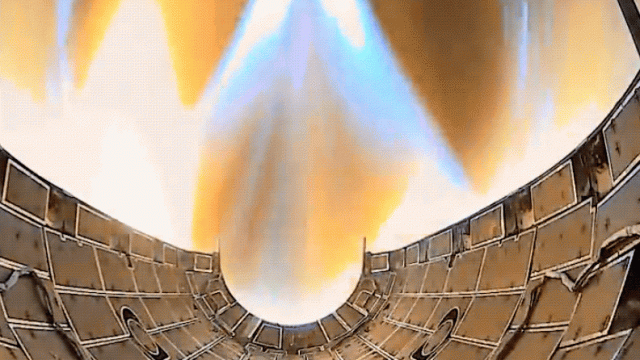The most recent flight of SpaceX’s Falcon Heavy was historic in that it was the rocket’s first fully expendable mission, and it was also the first Falcon Heavy mission to include previously flown fairings. As new footage attests, the fiery return of these fairings was a sight to behold.
After several delays, the Falcon Heavy blasted off from Launch Complex 39A at NASA’s Kennedy Space Centre in Florida on Sunday, April 30 at 8:26 p.m. ET. The triple-core rocket successfully deployed its primary payload, the broadband ViaSat-3 Americas satellite, and two smaller satellites to geosynchronous Earth orbit (GEO).
Key to SpaceX’s ongoing success is its devotion to reusability — it’s a lot cheaper to recover your engines and reuse them than to produce new ones for every launch. For this mission, however, none of the rocket’s three booster stages could be recovered, as they expelled all their fuel in the effort to get the payloads to GEO. That said, SpaceX did make the attempt to recover the rocket’s fairings, so in that sense it wasn’t a fully expendable mission.
Fairings are the part of the rocket that encapsulates and protects payloads launched to space. SpaceX has recycled previously flown fairings before, but Sunday’s launch marked the first time this was done for a Falcon Heavy, a rocket that’s basically three Falcon 9s strapped together.
Newly released SpaceX video of the ViaSat-3 mission shows stage separation, second stage engine startup, and the jettisoning of the fairings, which split apart as two halves and fell back to Earth.
Stage separation at sunset, followed by second stage engine startup, and payload fairing deploy pic.twitter.com/QOecwdHx4s
— SpaceX (@SpaceX) May 2, 2023
A second video provides a POV perspective of one fairing’s free fall through the atmosphere. In a tweet, SpaceX said fairing reentry for this mission “was the hottest and fastest we’ve ever attempted.” Reaching 15 times the speed of sound, the reentering fairing produced a “large trail of plasma in its wake,” the company wrote.
Fairing reentry on the ViaSat-3 mission was the hottest and fastest we’ve ever attempted. The fairings re-entered the atmosphere greater than 15x the speed of sound, creating a large trail of plasma in its wake pic.twitter.com/VgdlH6r3yR
— SpaceX (@SpaceX) May 2, 2023
The fairing later deployed its parachute and performed a soft water landing in the Atlantic Ocean. The fairing recovery ship, named Doug (in honour of Crew Dragon Demo-2 astronaut Doug Hurley), retrieved the fairing far from Florida. This was “the farthest downrange landing and recovery of fairings” to date at over 1,200 miles (1,930 kilometers) from the launch site, which is “nearly a third of the way to Africa,” according to SpaceX.
It may be a while before Falcon Heavy’s successor, SpaceX’s Starship megarocket, enters into the company’s regular operations. Until then, this very excellent heavy launch vehicle will undoubtedly continue to impress.
Want to know more about Elon Musk’s space venture? Check out our full coverage of SpaceX’s Starship megarocket and the SpaceX Starlink internet satellite megaconstellation Twitter and bookmark Gizmodo’s dedicated Spaceflight page.
